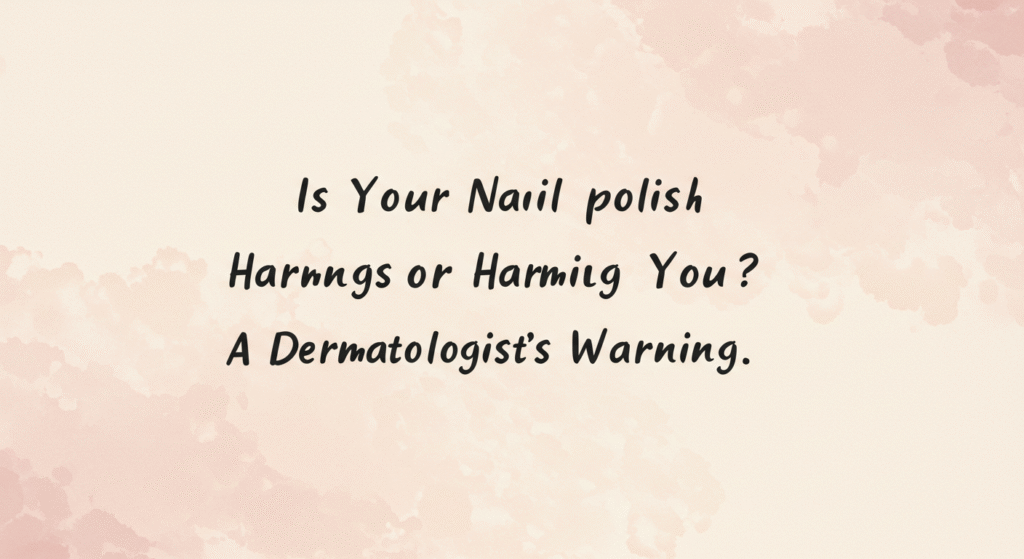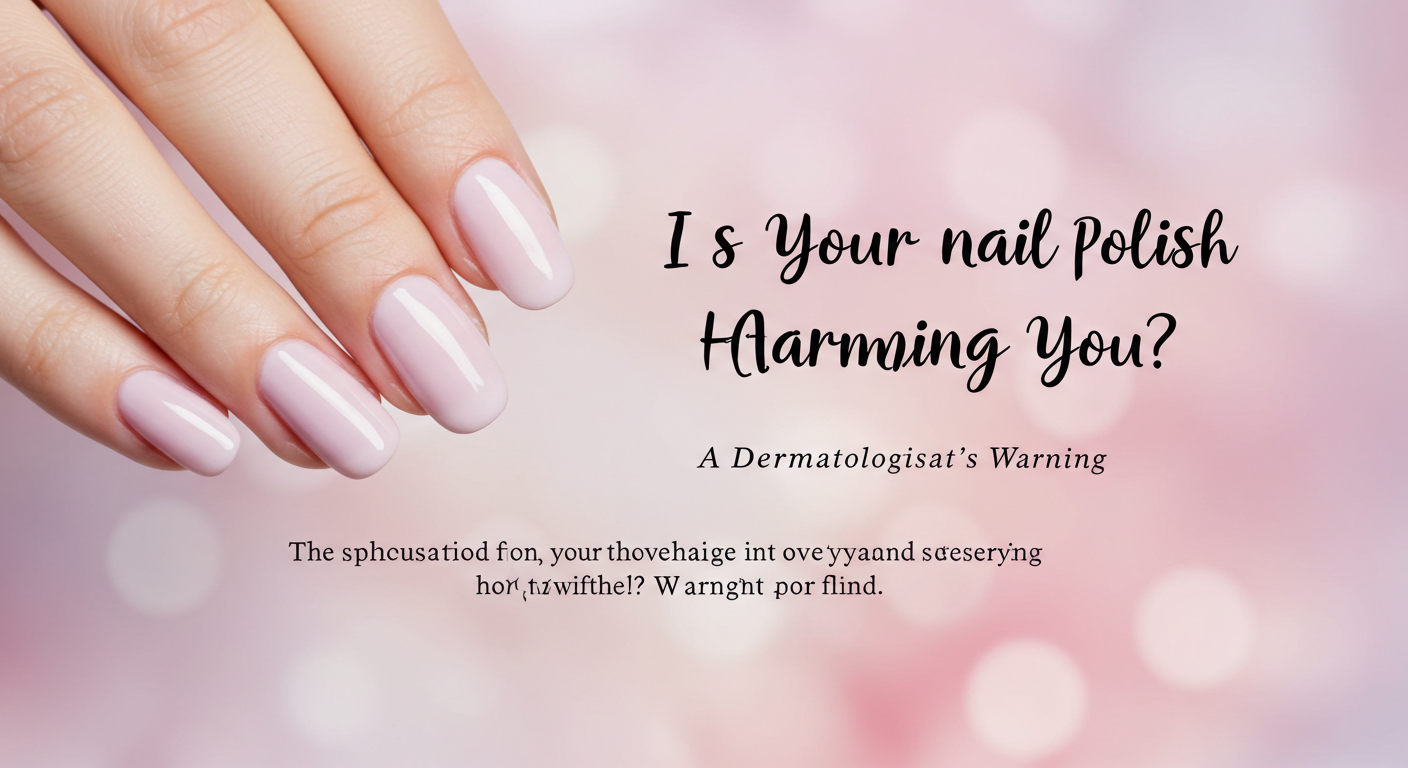Nail paints can harm your nails and skin too, a dermatologist explains how
We always try to look better but sometimes in the process we end up harming ourselves. In this article, learn about the harmful effects of excessive use of nail paint on nails and ways to prevent them to enhance the beauty of your hands.
Perhaps you love the beauty of your smooth, polished nails, but you often look at your nails and wonder: Does nail polish have any harmful effects? Are nails healthier without polish? Usually, the answer is yes — but that doesn’t mean you should steer clear of nail polish forever. Here’s how nail polish can affect the health of your nails and skin.
There are different types of nail paints
Nowadays women use many types of nail paints, these nail paints available in different colors are available in the market from many companies and bases. There are many different types of nail polish available in the market. You can apply nail polish to natural or artificial nails. Here are the types of nail polish:
1. Traditional nail polish
This is applied in several coats and air dries. It can be easily removed with an acetone-based nail polish remover. This is the type most people apply at home.
2. Gel Polish
A salon technician applies it to the nail, then cures it under a lamp so it dries almost instantly.
3. Powder dip polish
A technician applies a glue-like polish and then dips the nail in acrylic powder. A liquid is then applied that forms a hard coating.
Is nail polish harmful for nails?

Dr. Vijay Singhal, Senior Consultant, Dermatologist, Sri Balaji Action Medical Institute, Delhi says that “If you do not use nail polish carefully, you may develop a variety of skin and health problems.
Some nail polishes contain formaldehyde, toluene, and dibutyl phthalate (DBP) and other harshly reactive ingredients. Regular use of nail polish can have some negative effects on nails. Here are some reasons why nail polish can be harmful to nails:
- Continuously applying nail polish can make nails weak and fragile. It can reduce nail growth.
- Some nail polishes contain ingredients that can absorb moisture from the nails, increasing dryness.
- Some people may be allergic to the chemicals in nail polish, which can cause itching, redness, burning, or swelling.
- Applying nail polish for a long time can cause yellowing of nails and discoloration of skin.
- When nail polish come in contact with skin can cause skin problems. Such as skin cancer etc.
- Some chemicals present in nail polish can also cause hormonal imbalance.
Therefore, it is important to give nails a break from time to time and also choose good quality nail polish.
Can the harmful effects of nail polish be prevented?
Many people love manicured or painted nails. If you are one of them, here are some ways suggested by Dr. Vijay that can help avoid potential problems that may arise from them:
- Do not keep nail polish for too long after applying it once, two weeks are enough for this.
- Do not remove gel or powder dip polish yourself, removing it yourself can damage the nails. Make an appointment with a manicurist to get it removed.
- Use LED curing lights at the salon; these cure nails quicker than UV lights, so your hands need to be exposed to the light for less time.
- Save nail polish for special occasions, avoid using it on a daily basis.
- Give your nails time to heal themselves. And avoid using nail polish for some time.
- Use brands with fewer chemicals, choose nail paints that contain fewer toxins.
- Apply sunscreen on your hands while you are applying gel polish, which has SPF 30 or higher. This will help prevent skin cancer and premature skin aging.
- Clean the nails before applying nail paint, let the nail paint dry thoroughly, use nail remover to remove the nail paint.
- Never let the technician cut your cuticles. They work to protect your nails and surrounding skin from infection. You can gently push back your cuticles yourself after a shower, when they are softer.
- Do not dip your entire fingers or hands directly into acetone. At home, you can use cotton balls for traditional nail polish removal.
- Small cuts on your skin can allow bacteria to enter and cause infection. If you shave before a pedicure, this can increase the risk of infection.
- Use cream or petroleum jelly to moisturize them after removing the polish.
Along with this, you should also keep in mind that if you are using nail paint and you are facing any kind of problem like itching, burning sensation in the hands, or pain in the skin around the nails, swelling etc., then immediately consult a doctor.
FAQs: Harmful Effects of Nail Polish & Nail Care Tips
1. Is nail polish bad for your nails?
Yes, frequent use of nail polish can harm your nails and surrounding skin.
It may cause:
- Weak, brittle, and fragile nails
- Yellowing and discoloration
- Dryness and reduced nail growth
- Allergic reactions such as itching, redness, and swelling
- Skin problems and, in rare cases, skin cancer due to certain chemicals
- Hormonal imbalances from toxic ingredients like formaldehyde, toluene, and DBP
Tip: Always choose high-quality, toxin-free nail polishes and give your nails a break between manicures.
2. What are the harmful chemicals found in nail polish?
Some common toxic ingredients in nail polish include:
- Formaldehyde – can cause skin irritation and even cancer with prolonged exposure.
- Toluene – affects nail growth and may cause dizziness or headaches.
- Dibutyl Phthalate (DBP) – linked to hormonal imbalance and reproductive issues.
- Camphor & Parabens – cause allergies and skin reactions.
Look for labels like “5-Free,” “7-Free,” or “10-Free” nail polishes to minimize health risks.
3. Can nail polish cause yellow nails?
Yes, keeping nail polish on for too long can stain your nails, leading to yellowing and discoloration.
This is often caused by:
- Chemical pigments in darker nail polish shades
- Continuous application without breaks
- Lack of proper nail cleaning before applying polish
Prevention Tip: Apply a base coat before using colored nail polish and take breaks between manicures to allow nails to breathe.
4. How long should you leave nail polish on your nails?
You should not keep nail polish on for more than two weeks.
- Leaving it longer can cause nail weakening and discoloration.
- Always remove nail polish gently using a mild acetone-free remover.
- Give your nails at least a few days of rest before reapplying.
5. How can you safely remove gel or dip powder nails?
Never try to remove gel polish or dip powder at home by peeling or scraping, as it can damage the nail bed.
- Visit a professional manicurist for safe removal.
- Avoid soaking your entire fingers in acetone.
- Use cotton balls soaked in remover instead.
Improper removal can lead to nail thinning, peeling, and infections.
6. Can nail polish cause allergies or skin irritation?
Yes, some people are sensitive to certain chemicals in nail polish, which may cause:
- Itching around the nails
- Redness or swelling
- Burning sensation
- Pain or skin peeling
If symptoms occur:
- Remove the polish immediately.
- Apply a soothing cream.
- Consult a dermatologist if irritation worsens.
7. How to protect nails while using nail polish?
Follow these tips to keep your nails healthy while enjoying nail polish:
- Use toxin-free nail polish brands.
- Apply sunscreen on your hands before UV or LED curing to prevent skin damage.
- Moisturize nails and cuticles regularly.
- Avoid cutting cuticles — gently push them back instead.
- Clean nails thoroughly before applying polish.
- Give your nails rest periods between manicures.
8. Can using nail polish cause hormonal problems?
Some chemicals in nail polish, especially DBP (Dibutyl Phthalate), are considered endocrine disruptors, which can:
- Interfere with natural hormone balance
- Affect reproductive health
- Cause long-term health issues if used excessively
Always choose chemical-free nail polish labeled as safe and toxin-free.
9. Why should you avoid UV lamps during gel manicures?
UV lamps used in salons for curing gel nails emit harmful ultraviolet rays, which:
- Increase the risk of skin cancer on hands
- Cause premature aging and dark spots
Safer alternative:
- Use LED curing lights, which are faster and emit less harmful radiation.
10. When should you see a doctor for nail problems?
Seek medical attention immediately if you experience:
- Persistent pain or swelling around nails
- Severe itching or burning sensation
- Pus, discharge, or redness (signs of infection)
- Nails separating or breaking unusually
Early treatment can prevent serious nail or skin conditions.
READ ALSO: 10 DIY Nail Art Tips You Can Do at Home
Was this helpful?
Your feedback helps us create better content
Thank you for your feedback!
Your input helps us improve our content.




